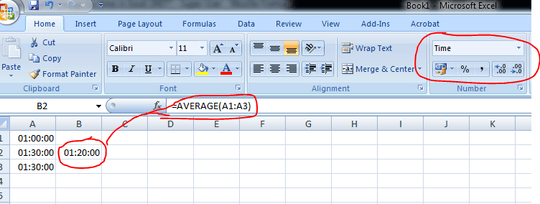7
1
I have these values
01:15
05:00
01:31
02:00
02:21
02:39
03:29
08:00
I highlighted all these cells and went to format cells -> custom -> and choose mm:ss
I then tried to use the built in average function in Excel 2007
=AVERAGE(D31:D38)
The result is 0.0
Of course this is not the number result that it should be(I have not calculated it manually yet but I am sure it is not 0).
I am not sure if it has the fact to do when you click on the cell it has something like this
"12:08:00 AM"
I am not sure if that is what is screwing it up.

1I think I know what happened. I had the fields as Time but I had average as decimal. When I changed it to time it worked. I then was able to use format cells and bring it down to mm:ss. – chobo2 – 2010-01-30T21:07:56.963
A very quick and efficient method, +1. – John T – 2010-01-30T23:12:07.533
Unfortunately this doesn't ignore zero duration fields which means that if you have e.g. a timesheet for a month for work, your average hour will be wrong until the end of the month. I did not get
AVERAGEIFto work properly. Any ideas? – Julian F. Weinert – 2015-01-15T11:41:20.923@Julian - I disagree, it is actually doing it's job - an average of 3,6,0 across three fields makes for an average 3... If you don't want certain cells to appear in the average, don't include them, but I don't believe this is a problem. – William Hilsum – 2015-01-15T16:55:05.297
I mean TIME DURATION, so the cell type must be duration and the values would be 00:35,00:00,08:46. doesn't work for me, might be a bug... – Julian F. Weinert – 2015-01-15T23:34:42.803